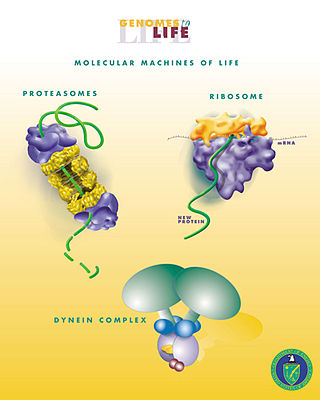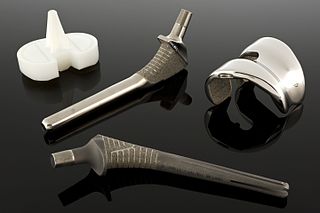Related Research Articles

Biomedical engineering (BME) or medical engineering is the application of engineering principles and design concepts to medicine and biology for healthcare applications. BME is also traditionally logical sciences to advance health care treatment, including diagnosis, monitoring, and therapy. Also included under the scope of a biomedical engineer is the management of current medical equipment in hospitals while adhering to relevant industry standards. This involves procurement, routine testing, preventive maintenance, and making equipment recommendations, a role also known as a Biomedical Equipment Technician (BMET) or as a clinical engineer.

Mechanical engineering is the study of physical machines that may involve force and movement. It is an engineering branch that combines engineering physics and mathematics principles with materials science, to design, analyze, manufacture, and maintain mechanical systems. It is one of the oldest and broadest of the engineering branches.

Biomechanics is the study of the structure, function and motion of the mechanical aspects of biological systems, at any level from whole organisms to organs, cells and cell organelles, using the methods of mechanics. Biomechanics is a branch of biophysics.

An implant is a medical device manufactured to replace a missing biological structure, support a damaged biological structure, or enhance an existing biological structure. For example, an implant may be a rod, used to strengthen weak bones. Medical implants are human-made devices, in contrast to a transplant, which is a transplanted biomedical tissue. The surface of implants that contact the body might be made of a biomedical material such as titanium, silicone, or apatite depending on what is the most functional. In 2018, for example, American Elements developed a nickel alloy powder for 3D printing robust, long-lasting, and biocompatible medical implants. In some cases implants contain electronics, e.g. artificial pacemaker and cochlear implants. Some implants are bioactive, such as subcutaneous drug delivery devices in the form of implantable pills or drug-eluting stents.
Neural engineering is a discipline within biomedical engineering that uses engineering techniques to understand, repair, replace, or enhance neural systems. Neural engineers are uniquely qualified to solve design problems at the interface of living neural tissue and non-living constructs.
Articles related specifically to biomedical engineering include:
Applied mechanics is the branch of science concerned with the motion of any substance that can be experienced or perceived by humans without the help of instruments. In short, when mechanics concepts surpass being theoretical and are applied and executed, general mechanics becomes applied mechanics. It is this stark difference that makes applied mechanics an essential understanding for practical everyday life. It has numerous applications in a wide variety of fields and disciplines, including but not limited to structural engineering, astronomy, oceanography, meteorology, hydraulics, mechanical engineering, aerospace engineering, nanotechnology, structural design, earthquake engineering, fluid dynamics, planetary sciences, and other life sciences. Connecting research between numerous disciplines, applied mechanics plays an important role in both science and engineering.

Biological engineering or bioengineering is the application of principles of biology and the tools of engineering to create usable, tangible, economically viable products. Biological engineering employs knowledge and expertise from a number of pure and applied sciences, such as mass and heat transfer, kinetics, biocatalysts, biomechanics, bioinformatics, separation and purification processes, bioreactor design, surface science, fluid mechanics, thermodynamics, and polymer science. It is used in the design of medical devices, diagnostic equipment, biocompatible materials, renewable energy, ecological engineering, agricultural engineering, process engineering and catalysis, and other areas that improve the living standards of societies.

A biomaterial is a substance that has been engineered to interact with biological systems for a medical purpose – either a therapeutic or a diagnostic one. The corresponding field of study, called biomaterials science or biomaterials engineering, is about fifty years old. It has experienced steady growth over its history, with many companies investing large amounts of money into the development of new products. Biomaterials science encompasses elements of medicine, biology, chemistry, tissue engineering and materials science.
This is an alphabetical list of articles pertaining specifically to Engineering Science and Mechanics (ESM). For a broad overview of engineering, please see Engineering. For biographies please see List of engineers and Mechanicians.

Synopsys Simpleware ScanIP is a 3D image processing and model generation software program developed by Synopsys Inc. to visualise, analyse, quantify, segment and export 3D image data from magnetic resonance imaging (MRI), computed tomography (CT), microtomography and other modalities for computer-aided design (CAD), finite element analysis (FEA), computational fluid dynamics (CFD), and 3D printing. The software is used in the life sciences, materials science, nondestructive testing, reverse engineering and petrophysics.

OrthoCAD Network Research Cell is a federally funded research and development facility in the Indian Institute of Technology Bombay, Mumbai, India. The Laboratory's primary function is the design and development of reconstruction systems for orthopaedic and other applications, the current focus is on mega-implants for limb-saving surgery, mainly for children affected by bone cancer. The Cell later led to the establishment of Biomedical Engineering and Technology (incubation) Centre (BETiC).

Nanobiomechanics is an emerging field in nanoscience and biomechanics that combines the powerful tools of nanomechanics to explore fundamental science of biomaterials and biomechanics.

Cone beam computed tomography is a medical imaging technique consisting of X-ray computed tomography where the X-rays are divergent, forming a cone.

Scott L. Delp is an American academic who is the James H. Clark Professor of Bioengineering and Mechanical Engineering at Stanford University. He is the Founding Chairman of the Department of Bioengineering at Stanford, the Director of the National Center for Simulation in Rehabilitation Research (NCSRR), Simbios, the NIH Center for Physics-Based Simulations of Biological Structures at Stanford., and the Mobilize Center, a data science research center focused on mobile health.

Gerhard Alfred Holzapfel is an Austrian scientist, (bio)mechanician. He is currently a professor of Biomechanics and Head of the Institute of Biomechanics at Graz University of Technology, Austria, since 2007. He is also the International Chair of Biomechanics at the Norwegian University of Science and Technology (NTNU), and a visiting professor at the School of Mathematics and Statistics, University of Glasgow, Scotland. He was a professor of biomechanics at KTH Royal Institute of Technology in Stockholm, Sweden, for 9 years until 2013. He is the co-founder and co-editor-in-chief of the international scientific journal Biomechanics and Modeling in Mechanobiology by Springer Nature since the first issue published in June 2002.
Alloplasty is a surgical procedure performed to substitute and repair defects within the body with the use of synthetic material. It can also be performed in order to bridge wounds. The process of undergoing alloplasty involves the construction of an alloplastic graft through the use of computed tomography (CT), rapid prototyping and "the use of computer-assisted virtual model surgery." Each alloplastic graft is individually constructed and customised according to the patient's defect to address their personal health issue. Alloplasty can be applied in the form of reconstructive surgery. An example where alloplasty is applied in reconstructive surgery is in aiding cranial defects. The insertion and fixation of alloplastic implants can also be applied in cosmetic enhancement and augmentation. Since the inception of alloplasty, it has been proposed that it could be a viable alternative to other forms of transplants. The biocompatibility and customisation of alloplastic implants and grafts provides a method that may be suitable for both minor and major medical cases that may have more limitations in surgical approach. Although there has been evidence that alloplasty is a viable method for repairing and substituting defects, there are disadvantages including suitability of patient bone quality and quantity for long term implant stability, possibility of rejection of the alloplastic implant, injuring surrounding nerves, cost of procedure and long recovery times. Complications can also occur from inadequate engineering of alloplastic implants and grafts, and poor implant fixation to bone. These include infection, inflammatory reactions, the fracture of alloplastic implants and prostheses, loosening of implants or reduced or complete loss of osseointegration.
Ellen Roche is an Irish biomedical engineer and Associate Professor at MIT in the Department of Mechanical Engineering and the Institute of Medical Engineering and Science. She has contributed to heart failure prevention with her inventions, the Harvard Ventricular Assist Device (HarVAD), a soft-robotic sleeve device that goes around the heart, squeezing and twisting it to maintain the heart’s functionality, and Therepi, a reservoir that attaches directly to damaged heart tissue.
Lucas H. Timmins is an American biomedical engineer and currently an associate professor at Texas A&M University. He is active in the fields of computational and experimental biomechanics and the application of these research domains to address prevalent challenges in cardiovascular medicine.
Jonathan Jeffers is a mechanical engineer and Professor of Mechanical Engineering at Imperial College London. He was awarded a Research Professorship by the National Institute for Health and Care Research (NIHR), the first engineer to receive this award. His research focuses on improving surgical treatment of osteoarthritis.
References
- ↑ "7.2.1 Biomechanical Engineering". UC Berkeley Mechanical Engineering. 2019-01-30. Retrieved 2023-06-17.
- 1 2 "Biomechanical Engineering Courses | Mechanical Engineering". me.stanford.edu. Retrieved 2023-06-17.
- ↑ "What Does a Biomechanical Engineer Do? (Job Titles Included)" . Retrieved 2022-11-14.
- ↑ Sajjadinia, Seyed Shayan; Haghpanahi, Mohammad; Razi, Mohammad (September 2019). "Computational simulation of the multiphasic degeneration of the bone-cartilage unit during osteoarthritis via indentation and unconfined compression tests". Proceedings of the Institution of Mechanical Engineers, Part H: Journal of Engineering in Medicine. 233 (9): 871–882. doi:10.1177/0954411919854011. ISSN 0954-4119. PMID 31232647. S2CID 195328808.
- ↑ Msallem, Bilal; Maintz, Michaela; Halbeisen, Florian S.; Meyer, Simon; Sigron, Guido R.; Sharma, Neha; Cao, Shuaishuai; Thieringer, Florian M. (January 2022). "Biomechanical Evaluation of Patient-Specific Polymethylmethacrylate Cranial Implants for Virtual Surgical Planning: An In-Vitro Study". Materials. 15 (5): 1970. Bibcode:2022Mate...15.1970M. doi: 10.3390/ma15051970 . ISSN 1996-1944. PMC 8911603 . PMID 35269201.
- ↑ Keaveny, T.M.; Clarke, B.L.; Cosman, F.; Orwoll, E.S.; Siris, E.S.; Khosla, S.; Bouxsein, M.L. (2020-06-01). "Biomechanical Computed Tomography analysis (BCT) for clinical assessment of osteoporosis". Osteoporosis International. 31 (6): 1025–1048. doi:10.1007/s00198-020-05384-2. ISSN 1433-2965. PMC 7237403 . PMID 32335687.